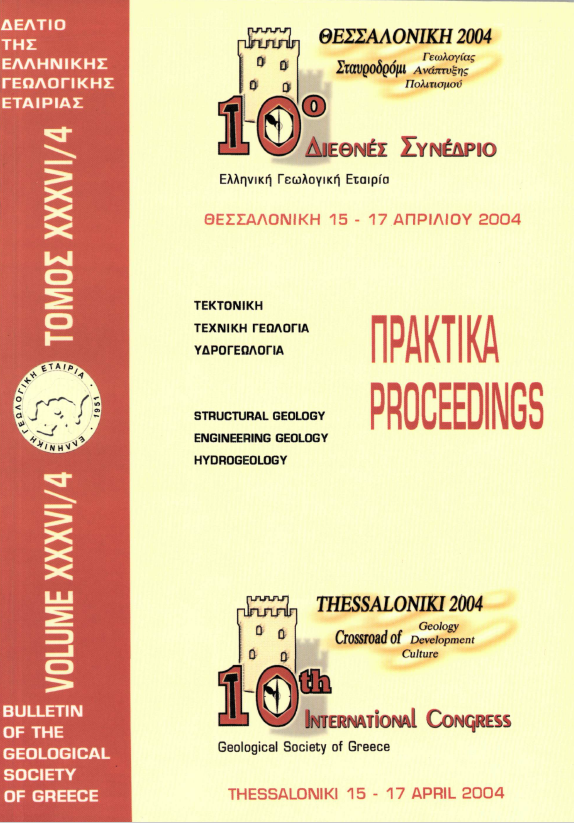GEOCHEMISTRY, GENESIS AND STRUCTURE OF HERCYNIAN GRANITOID ROCKS OF THE PELAGONIAN ZONE, FROM THE VORAS MT. (MACEDONIA, NORTHERN GREECE)
Abstract
The Ercynian plutonio rocks intruding the Paleozoic basement of the Pelagonian zone in the area of Kaimaktsalan (western Voras Mt.) are examined. They are composed of: hornblende-biotite granodiorites to granites (Hb)BtGrd, biotite granites (BtGr), monzonitic to monzodioritic mafic enclaves (MME) and leucogranites (LGr). The (Hb)BtGrd and BtGr are randomly distributed and exhibit transitional contacts, while both are intruded by the LGr. In the (Hb)BtGrd two types of biotites were found; one similar to MME biotites and another similar to BtGr. The amphiboles are magnesiohornblende and edenite. The Nb vs. Y and Rb vs. Y+Nb plots of the rock-samples indicate the strong relationship of both (Hb)BtGrd and BtGr with a volcanic arc (VAG) geotectonic setting, while the LGr are plotted in the syn-collision (syn-COLG) field. Both the (Hb)BtGrd and BtGr are plotted in the field of the pre- or post-collisional granites, whereas the LGr reveal the characteristics of the syn-collisional anatectic granites (R1-R2 diagram). The majority of the major elements show wellcorrelated trends with differentiation starting from the more basic MME up to the LGr or the BtGr while, the behaviour of trace elements is characterized by significant changes between MME and (Hb)BtGrd+BtGr. The Kaimaktsalan granitoids show calc-alkaline affinity. The Rb/Sr vs. 1/Sr and Rb/V vs. 1/V display straight line trends for (Hb)BtGrd+BtGr indicative of mixing processes. Based on the field observations, mineralogical composition and geochemistry of the rock types, a two-stage process for the formation of MME, (Hb)BtGrd and BtGr is suggested. In the first stage, a basic magma of mantle origin, and composition similar to the more basic MME underwent fractional crystallization, while it was mixed with an acid magma of crustal origin and composition similar to the most acid BtGr. This mixing-fractional crystallization (MFC) process has low r, due to the difference in composition and viscosity of the two magmas. This process resulted in the formation of the most basic (Hb)BtGrd. In the second stage, the resulted magma was fractionated and mixed with the fore mentioned crustal magma, but with higher (r) giving the (Hb)BtGrd and BtGr. Sub-parallel and crosscutting trends between the LGr and BtGr suggest that the former do not represent an evolved magma of the latter, but a separated intrusion. Four main deformational events (Di, D2, D3 and D4) of Alpine age and plastic to semi-plastic conditions affected the crystalline basement of the Pelagonian zone in the broader area of the Voras Mt. as well as the Ercynian plutonio rocks. The Drevent is related to a Late Jurassic-Lower Cretaceous Si-schistosity associated with Mi-paragenesis of Qtz+Kf+Ab+Phe+Bt+Hb+ Ep/Czo±Tit±Garn. During the Middle Cretaceous the Si-schistosity was overprinted by an S2-axial plane schistosity of tight, recumbent to inclined B2-folds (D2-event). The S2-schistosity has NW-SE strike and dips either towards the SW or NE. It is characterized by the syn-kinematic growth of Wm+Chl+Ab+Act+Qtz+Ep (M2-paragenesis) that forms an L2-stretching lineation striking NW-SE closely related with a transport direction towards the SE. The M1-paragenesis along the Sischistosity indicates that the Di event took place in the upper greenschist-lower amphibolitic metamorphic fades (~450-550°C). Also, the composition of the syn-Si phengite (max Si: 6,8) shows that the granites and orthogneisses of the crystalline basement of Kaimaktsalan have been metamorphosed in relatively high-pressure conditions (~8kb). The replacement of Bt with Chi and Hb with Act and Chi indicates that the M2-paragenesis took place below the ~450°C. The D2-event was succeeded by a younger D3-event that took place in semi-plastic conditions in Late Cretaceous. The D3-event is characterized by NNW-SSE to NE-SWextensional Sb3-shear zones and a stretching lineation associated with a top to the SE sense-of-shear. During the Tertiary and in more cold conditions, NW-SE striking Sb4-shear zones with ultra-cataclastites and sense-of-shear mainly top to the SW were formed due to the Drevent affecting all the previous structures.
Article Details
- How to Cite
-
Αυγερινός A., Κίλιας Δ., Κορωναίος A., & Μουντράκης Δ. (2004). GEOCHEMISTRY, GENESIS AND STRUCTURE OF HERCYNIAN GRANITOID ROCKS OF THE PELAGONIAN ZONE, FROM THE VORAS MT. (MACEDONIA, NORTHERN GREECE). Bulletin of the Geological Society of Greece, 36(4), 1540–1549. https://doi.org/10.12681/bgsg.16511
- Section
- Tectonics and Geodynamics

This work is licensed under a Creative Commons Attribution-NonCommercial 4.0 International License.
Authors who publish with this journal agree to the following terms:
Authors retain copyright and grant the journal right of first publication with the work simultaneously licensed under a Creative Commons Attribution Non-Commercial License that allows others to share the work with an acknowledgement of the work's authorship and initial publication in this journal.
Authors are able to enter into separate, additional contractual arrangements for the non-exclusive distribution of the journal's published version of the work (e.g. post it to an institutional repository or publish it in a book), with an acknowledgement of its initial publication in this journal. Authors are permitted and encouraged to post their work online (preferably in institutional repositories or on their website) prior to and during the submission process, as it can lead to productive exchanges, as well as earlier and greater citation of published work.





